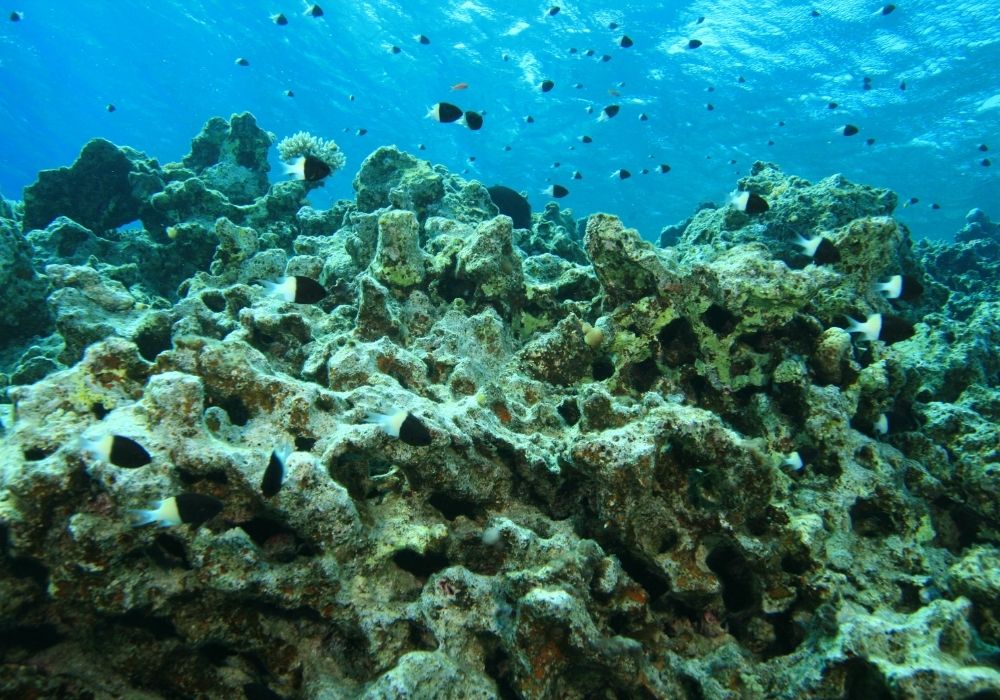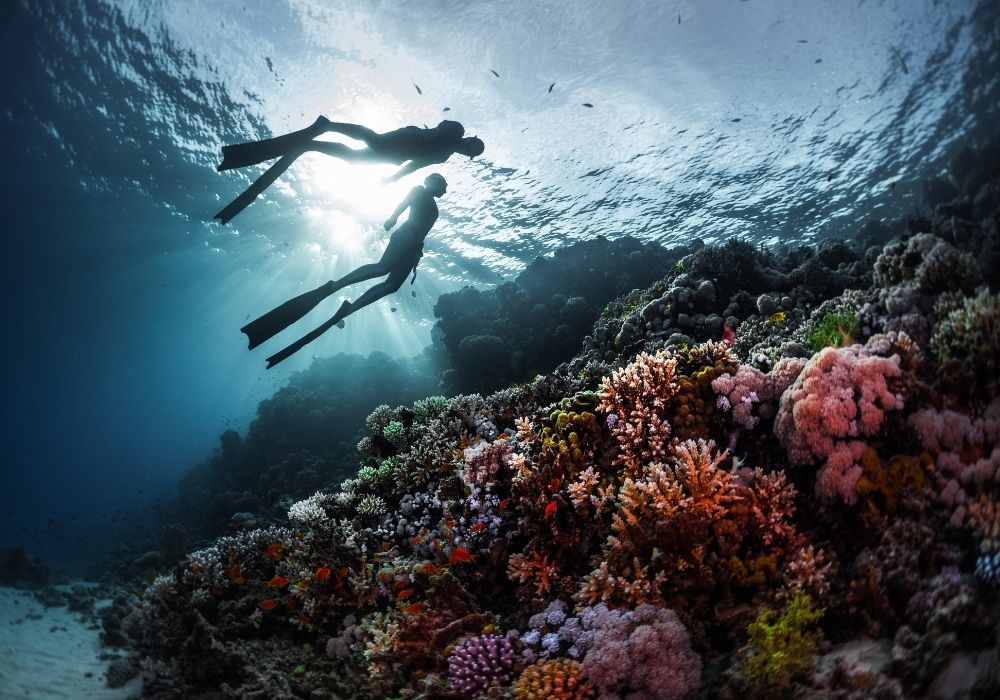“This is the first time in human history where we’ve been on the verge of losing a planetary scale ecosystem, and it is arguably the most diverse one on the planet and one of the most valuable” – Richard Vevers
You are probably aware that the Great Barrier Reef, the world’s largest coral reef and one of the seven natural wonders of the world, is at risk of dying out.
You may also know that is not only the Great Barrier Reef that is at risk, but coral reefs across the planet.
Today, there is 40-50% less coral on the reefs of the world than there were three decades ago. It’s pretty shocking. And it’s easy to ignore the scale of the problem when it’s ‘out of sight, out of mind’ for many.
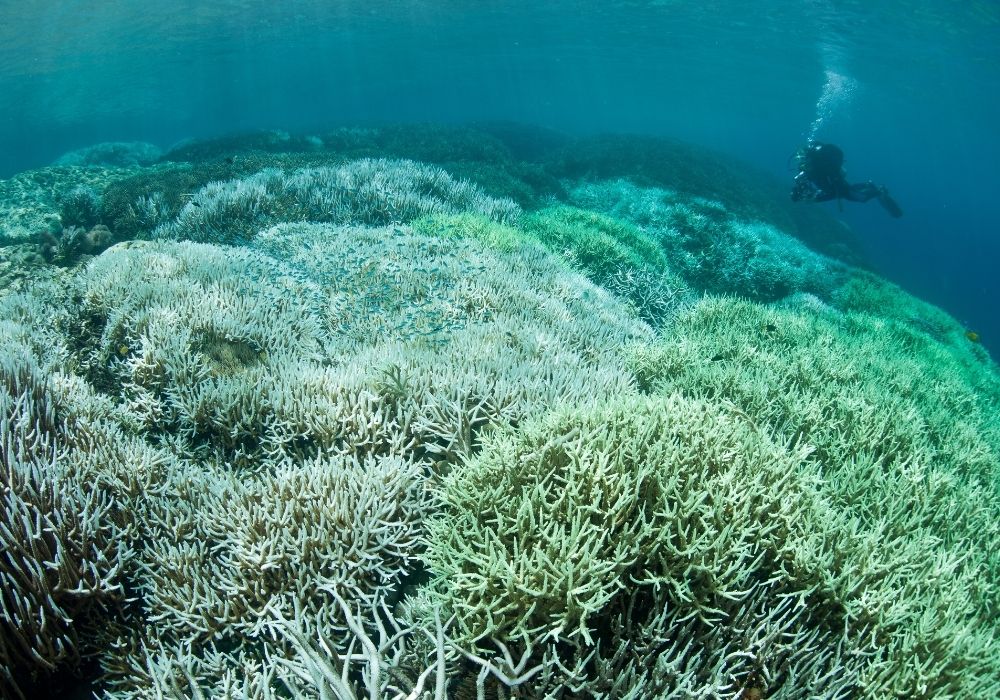
Coral reefs are extremely important to the planet and are home to an extraordinary amount of wildlife, as well as being living creatures themselves.
It is crucial that we understand the importance of these incredible structures and act now to save them – before it’s too late.
We will give you the lowdown on the issue of coral reef bleaching and death. And fill you in on the work is being done by scientists and conservationists worldwide to save the coral. We’ll also tell you what you can do to help protect the coral reefs.
Why are coral reefs important?
Coral reefs are an enormous contributor to biodiversity in the oceans. When these habitats change or die, they have a big impact on both marine and other life.
Approximately 4,000 species of fish, and a quarter of marine species, at some point in their lives, rely on the coral reefs even though corals make up only 1% of the marine environment. These marine species include fish, algae and turtles, among others.
When the coral reefs die, these animals die too, and scientists predict that many of these species will go extinct. 40% of all marine environments are thought to have been severely altered.
Coral reefs not only support marine life. They also protect shores from hurricanes by acting as barriers. 200 million people are reliant on the corals to protect them from waves and storm surges.
Dr. Michael Cuttler from the ARC Centre of Excellence for Coral Reef Studies said “Reefs can effectively protect shorelines because of their ability to cause waves to break offshore, thus limiting the energy impacting the coastline”. This stops the beach from eroding as a result of tropical cyclones.
Without these natural barriers in the ocean, hurricanes would wreak more devastation on shorelines, marine species, coastal infrastructure and the communities that live there. And climate change increases the risk of such damage, with storms becoming ever more powerful and frequent.
The devastation of the 2004 Indian Ocean tsunami was mediated on some coastal areas by the presence of healthy coral reefs.
The alternative – building walls to protect shorelines – is extremely expensive. And many of the countries protected by the corals are developing nations.
As well as protection from storms, 500 million people are supported by the corals – tourism and fishing that rely on healthy coral. Coral reefs provide $375 billion in economic value per year.
A large proportion of fisheries depend on coral reefs. It is estimated that 6 million fishermen rely on the coral reefs across the world.
Local economies also benefit hugely from tourism in these areas. This is from diving, snorkelling, and other activities that rely on the reefs.
Coral reefs are also important for their significance in scientific research. Corals have similar proteins and genes to humans. It is even thought that some of these small plants and animals that create reefs can help scientists to treat illnesses such as cancer.
Coral reef research is also used to help find medicines for bacterial infections and viruses, arthritis, Alzheimer’s disease, heart disease and other illnesses. Without these coral reefs, potential cures for cancer and other diseases could be lost.
One example of such research is into sponges. These are creatures similar to corals, are immobile and produce certain chemicals as a means of self-protection. Some of these chemicals can replicate this protective function in humans, stopping cells from dividing and dominating.
There is a type of glass sponge which has been discovered to have a “potent anti-cancer compound”.
Some sponges from the Gulf of Mexico have been used to develop medication for breast cancer. As well as cancer drugs, the study of sponges has led to the development of certain antibiotics and knowledge on how to grow bone.
Destruction of the coral reefs may mean that we never develop these crucial life-saving treatments.
Why are the coral reefs dying?
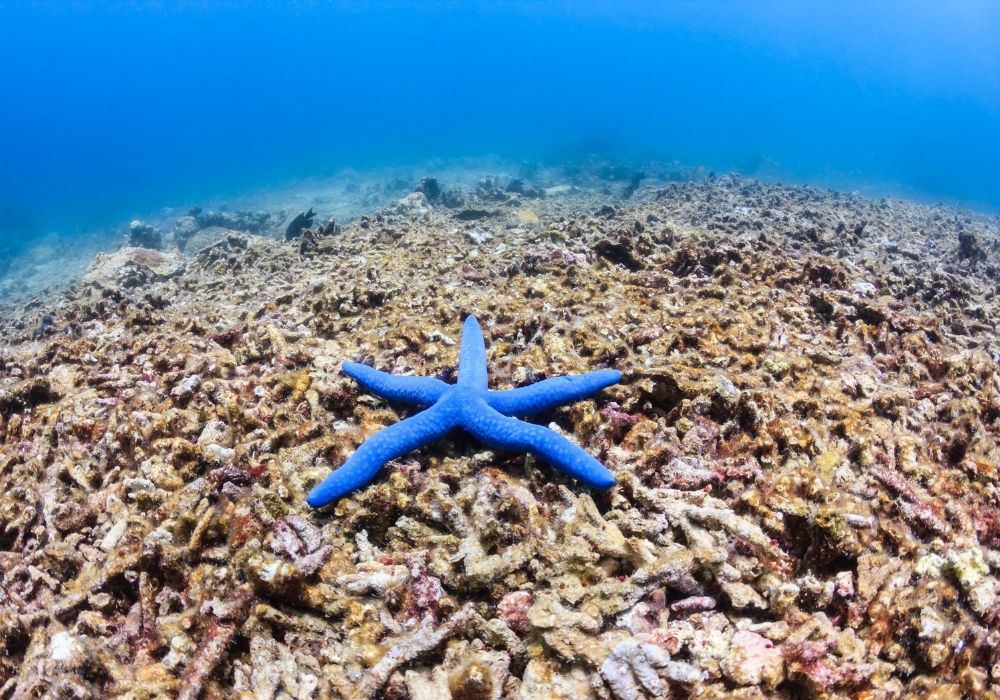
As with many environmental issues, there is not one simple answer. Coral death is a complex issue with multiple causes. The corals are dying for the following reasons:
1. Ocean warming. The oceans soak up over 90% of the additional heat that is produced on Earth. Corals grow over hundreds of years, but they can die within just two summers if they experience excessive heat.
A change of only 1.5 degrees Celsius is enough to kill off the coral. And our oceans are getting warmer every year.
2. Ocean acidification. The oceans absorb 22 million tons of CO2 each day, making the oceans more acidic.
The oceans are more acidic than they have been for nearly half a million years. Corals find it harder to build their skeletons from calcium carbonate in more acidic water, meaning that they are more likely to be eroded.
It is thought that in thirty years, only 15% of coral reefs will be able to grow properly. Acidification also affects the development of species that help the coral to grow. Corals also bleach more easily when the ocean becomes more acidic.
3. Overfishing. Corals rely on the fish that live in the reefs to eat the algae that live inside them. They also eat the small organisms that would otherwise stop the coral from getting light and nutrients. This then affects the symbiotic relationship that these species have with the coral. For example, the algae can then begin to dominate the coral.
These species are reliant on one another. Meaning that a decline in one population will reduce a food source in another and lead to further decline.
A significant decline or extinction of a particular species affects the entire food chain. It is not just the fish to be eaten that is removed from the food chain. Often, non-target species also get killed when fish are being caught.
4. Physical destruction. Fishing frequently damages the coral reefs when fishermen are trying to get fish out of the water. Their nets and other equipment drag along the ocean floor and destroy the coral. Some fishing techniques even use explosives to stun fish, which also kills off the corals.
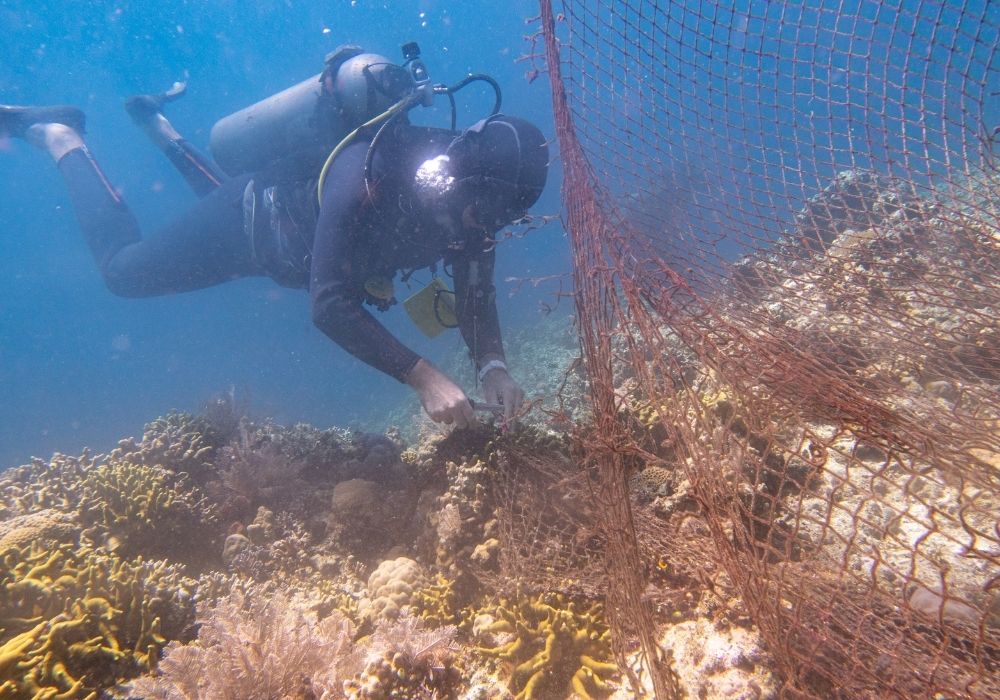
5. Disease. Corals are subject to disease caused by pathogens such as fungi, protozoa, bacteria, and possibly viruses. These diseases have increased in the last century, which are likely as a result of the environmental changes that corals are experiencing. This makes their habitat less suitable for them.
The tissues of the coral become injured or infected and this spreads across the whole colony, resulting in death. Corals in the Caribbean are more susceptible to disease than in other locations around the world.
Plastic increases the likelihood of corals contracting diseases from 4% to 89%. Pieces of plastic transport dangerous pathogens, which hitch a ride on the back of these plastics that travel vast distances across the oceans. These pathogens reach the vicinity of the coral, and are sometimes eaten by corals, causing disease.
Plastic can also block out light and oxygen. This means the corals are more likely to become diseased because they can’t get the nutrients they need. Pieces of sharp plastic can also cut the skin of the coral and lead to infection.
Coral damage is just one of the many problems caused by plastic in the ocean.
What is coral reef bleaching?
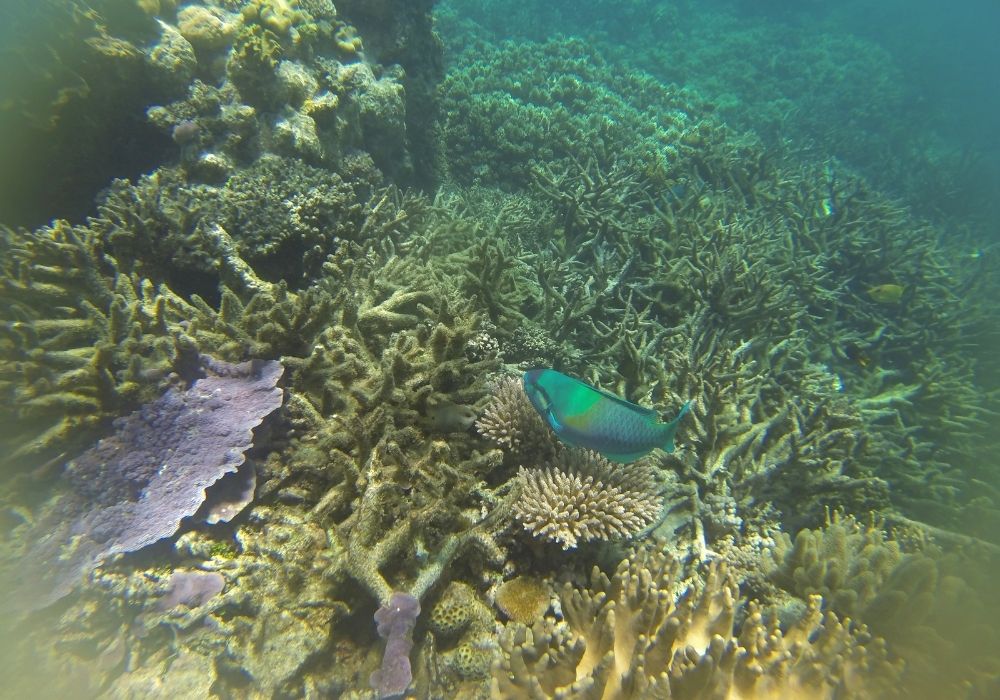
Coral get stressed when they get too hot or they are affected by pollution. When they get stressed, corals become bleached. This bleaching leads to disease and death.
The colour of coral comes from the algae, called zooxanthellae or symbiodinium that live inside them. They rely on these algae for nutrients that are produced through photosynthesis. When coral become stressed, they expel the algae which they have a symbiotic relationship with.
Expelling these algae makes the corals turn white and is why this damaging of the coral is known as ‘coral bleaching’.
Corals are brightly coloured when they are thriving, as they are getting all the nutrients they need. When the coral is white, it has expelled the algae which give it is food.
When coral becomes bleached, it is still living. But, it is at risk of starvation and death. When they die, they become dark brown.
The algae and the coral cannot exist without each other.
Not only does the coral die as a result of coral stress and bleaching. The animals that live in the coral die too. The water near bleached corals turns cloudy with all of the animals that are expelled from the coral and killed.
Coral bleaching was first noticed in the 1980s during several El Niño events. El Niño is a naturally occurring weather event that tends to raise temperatures. We will look at El Niño and its relationship with coral bleaching in the next section.
Bleaching is a natural process that occurs when oceans warm, but in the last century, has been occurring much more frequently in correlation with climate change. Global ocean heatwaves have been happening more and more often. This indicates that the increase in coral bleaching events is likely to be manmade.
The coral gets bleached when it becomes stressed from heat, pollution and other irritants. Coral reefs are hypersensitive to both pollutants in the water and changes in temperature. Temperature change is a big cause of coral bleaching, as are oil spills and pollution from shipping traffic.
What is El Niño and is it the cause of coral reef bleaching?
El Niño is a naturally occurring weather cycle in the Pacific Ocean which causes a range of weather events including higher temperatures in the Pacific. This tends to occur every two to seven years, and the warming usually lasts from a few weeks to a month.
When a longer El Niño cycle occurs, more warming takes place. In the last fifty years, six El Niño events have contributed to the mass extinction of corals due to bleaching. Coral reefs were killed in Panama, the Galapagos islands, Florida, the Caribbean, and Southeast Asia.
El Niño is not caused by climate change, however, climate change may affect how this natural weather pattern behaves. These El Niño warming episodes have taken place more and more frequently since the 1970s. Scientists are trying to investigate whether climate change is increasing El Niño.
Normally, corals are bleached during discrete El Niño events that take place within the time periods that we mentioned above. However, more recently, scientists have noticed that the coral is continuously being bleached. This indicates that it is not solely due to El Niño events because bleaching is happening outside of the normal El Niño cycles.
In 2016, the longest ever coral bleaching event occurred. 2020 has been the largest bleaching event that has been seen on the Great Barrier Reef.
Another potential cause of coral bleaching is when flood water washes into the ocean. This fresh warm water may have led to the increased production of plankton which creates ‘dead zones’ in the water because of low oxygen levels.
It also creates another layer of water above the normal saltwater, blocking out some of the light that is needed by the corals.
How quickly is coral reef dying?
Because of coral bleaching, there is a significant risk that coral reefs will be the first ecosystem to be wiped off the planet by human activity. By 2014, more than half of the world’s coral had already been killed off.
In 2017, Terry Hughes, director of the ARC Center of Excellence for Coral Reef Studies at James Cook University, found coral bleaching all the way along the Great Barrier Reef. The reef is a huge 1,500 miles in length.
Over 80% of the north part of the Great Barrier Reef has experienced extreme bleaching.
Scientists in Australia reported that in the 1980s, coral bleaching occurred every 25 to 30 years. Since 2010, a coral bleaching event has taken place every six years on average.
When corals become bleached, they can recover over a period of time. This occurs when the oceans cool after a period of warming.
However, in recent years, cooling has become increasingly rare. This means that corals don’t have a chance to recover after bleaching.
It only takes 1C of sustained change in temperature to affect the corals. Normally, as temperatures cool down, it takes ten to fifteen years for coral to recover from bleaching events.
In their Global Warming Report, IPCC state that a rise of 1.5C will kill 70-90% more coral reefs. A rise of 2C is likely to kill them all.
The first three months of 2020 had temperatures that were 0.7C above the average. And this is not unusual as temperatures increase year on year.
2016 was the warmest year on record. This was partly due to climate change and partly due to El Niño.
2020 has so far been the second-warmest year on record. 2019 was found to be the hottest year so far for the oceans of the world.
These figures all demonstrate that the planet is continuing to warm, threatening the existence of the world’s coral reefs.
What animals live in the coral reef – and what is the impact on them?
The coral itself is alive – it is a marine invertebrate. Each coral is called a polyp and a coral reef is made up of colonies of these polyps. Polyps have tentacles which they use to feed on plankton at night.
The coral produces CO2 and waste products that the algae use to photosynthesis. In turn, the algae provide the coral with oxygen and the by-products of photosynthesis. These are used to produce calcium carbonate and it is this that creates the skeleton of the coral reef.
Coral and the fish that live in the coral have a close relationship. The fish eat the algae from the corals. Because of this, the algae does not overrun the corals and they are able to get sunlight and oxygen.
One particular fish that lives in a symbiotic relationship with a specific type of coral (sea anemones) are clownfish. Sea anemones catch fish and shrimp in their tentacles using poisonous barbs. Clownfish have an immunity to the barbs so can live within the tentacles feeding on invertebrates that would otherwise harm the coral.
There are many relationships that exist like this between corals and other animals.
Thousands of different species can exist on a single coral. Other species include turtles, clams, lobsters, sea horses, sponges, eels, sharks, seaweed, bacteria, fungi, and sea turtles.
Coral bleaching impacts all of these animals in the reef because the coral cannot nourish itself once it has expelled its algae. Which means it cannot provide sources of food and shelter to these animals. This puts them at risk of death by starvation and because of predators.
The warmer waters do not only directly impact the coral. Reef fish find it more difficult to perform their functions because being in hotter water is more energy intensive.
Where are coral reefs located?
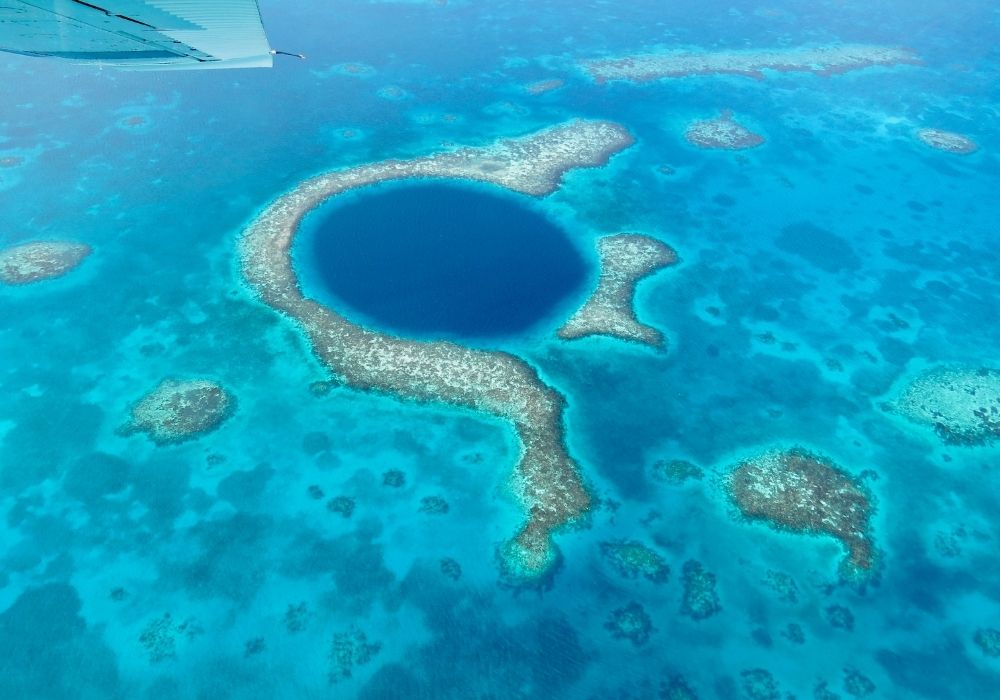
Coral reefs can be found in over a hundred countries worldwide, in warmer waters around the equator and in mid-tropical regions. They are in the Caribbean, the Pacific, the Red Sea, the Indian Ocean and the Persian Gulf, and found as far north as Southern Japan and Florida.
Coral reefs form in clear tropical waters where they can get light. This tends to be around 45 metres from the surface of the water. Shallow warm waters tend to have more calcium, which the reefs need for growth.
There are three different types of coral reefs, which are found in different locations.
Fringing reefs, mostly found in Hawaii and the Caribbean, are located along the shores of islands and continents.
Barrier reefs are a bit further aware from the shore. They are the most common in the Indo-Pacific and the Caribbean.
Atolls are low-lying coral islands which form around a central lagoon. These are most commonly found in the Indo-Pacific region.
The largest coral reef, and indeed the largest living thing on Earth, is the Great Barrier Reef in Australia. It covers 133,000 square miles.
Corals are located in areas with water between 20-28C. Reefs also tend to form in areas with a lot of waves as these bring oxygen and nutrition. They usually develop along the eastern shores for these reasons.
What is being done to save coral reefs?
Overfishing, pollution, climate change, physical destruction of coral habitats… It may sound like all is lost for the reefs. However, scientists and activist are trying to take action to save these delicate and precious ecosystems.
A study carried out over 44 years and published in July 2020 by Global Change Biology has found that reefs in the Eastern Tropical Pacific may have adapted to heat stress. Even in the worse instances of heating, the coral recovered within ten to fifteen years. This will help coral researchers to learn about how to help coral survive in other locations.
These particular corals are called pocilloporids – they reproduce more quickly than other species of coral and the algae that live in them are more resistant to heat. They may be more resistant to stress, or they may recover more quickly.
Creating marine protected areas, akin to national parks in the water, can help coral reefs to stay healthy. In these areas, recreation, fishing and mining are not allowed, putting the coral at less risk. There is the added benefit that fish caught near these areas tend to be healthier as fish depend on coral reefs.
Often, these protected marine areas need to be moved away from their original locations to parts of the ocean far away from humans.
Coral in these areas have a better chance at survival, and allows the existing coral to function better. However, having protected marine locations only counteracts some of the causes of coral bleaching and death. Protected areas do not stop the oceans from getting warmer.
The Elizabeth Moore International Center for Coral Reef Research and Restoration are making attempts to save coral using natural selection. They take coral that has survived stressors, breed them, and reattach them to the coral. They have managed to regrow 70,000 coral from five different species.
Marine biologist, David Suggett, and his team at the Future Reefs Program from Sydney’s University of Technology have been taking pieces of coral that survived the bleaching of 2016-2017. They have been re-growing 12 species of corals in a nearby sandy lagoon.
These corals have been able to be transplanted back onto the coral reef. This provides some hope that corals will recover. But this will only be known when other bleaching events occur and their survival rates can be determined.
Genetic modification of coral is another potential way of protecting the coral. Shedd Aquarium in Chicago has been carrying out genetic research on corals that have survived and those that haven’t. The hope is that this will help more heat-resistant coral to be bred by scientists.
Stephen Palumbi and his team from Stanford University have found some corals in American Samoa and Palau that are able to tolerate heat much better than other corals. Their work has allowed them to identify some of the genes that are responsible for this hardiness.
Other research has found some corals that are able to form their skeletons in water that is so acidic that it would kill corals in other locations. It’s possible that this type of coral will be more adaptable to the changing ocean environment.
There are measures being taken to try to stop damage from the fishing industry, such as reducing the number of people permitted to fish, closing sites seasonally to encourage breeding, restrictions on fishing gear, and limited the size and volume of different types of fish caught.
What can you do to help save coral reefs?
It is not just the responsibility of climate activists and scientists to protect our coral reefs and our oceans.
There are changes you can make in your life that will help, including lifestyle changes, supporting organisations making a difference, and enjoying the oceans responsibly.
1. Make lifestyle changes to counteract climate change.
Conserve water
Run-off freshwater and wastewater impacts coral reefs by degrading the water quality and creating dead zones where there is not enough oxygen.
Some of the measures you can take include:
- Reduce the amount you flush the toilet
- Take shorter, cooler showers
- Turn off taps when you aren’t using them (such as when you’re shaving or brushing your teeth)
- Fill up a jug to put in the fridge instead of waiting for the tap water to run cold – you could save 10 litres a day
- Use an eco-setting on your washer
- Fix dripping taps and toilets
- Use a water butt in your garden
- Buy second-hand clothes – the fashion industry uses huge amounts of fresh water
Reduce your carbon footprint
As we mentioned, climate change is the biggest threat to coral reef survival. The more people that take steps to reduce their carbon footprint, the less devastating the impact of climate change on the coral reefs.
You can:
- Reduce the amount of meat and dairy you eat
- Buy local produce and avoid wasting food by meal planning and freezing what you don’t use
- Cycle or walk instead of driving
- Reduce the amount you fly, or fly direct – a large proportion of emissions happen during take-off and landing
- Buy sustainable clothing – lots of ‘fast fashion’ items end up landfill, as well as using lots of water, as we mentioned
- Choose bank accounts, savings and organisations that don’t invest in fossil fuel. Better yet – invest in green and ethical funds that support renewable energy
- Buy products that are manufactured in the UK rather than buying products shipped from China
If you choose to eat seafood, choose sustainable seafood.
Coral reefs need healthy fish populations to survive.
Avoid eating fish and seafood that are at risk of overfishing. The Marine Conservation Society has a list of fish that come from sustainable stock. Greenpeace also has a list of ethically sourced tuna.
Bigger fish are also more likely to have reproduced, so choose those over smaller fish. Local fish, such as sea bream and sea bass in the UK, has a smaller carbon footprint.
Reduce your plastic consumption.
As well as being a massive pollutant of our oceans which damages and kills coral reefs, when plastic breaks down, it releases greenhouse gases which contribute to climate change. Also, plastics that aren’t recycled (which is the majority) are often incinerated. This process contributes to climate change.
Try replacing your plastic products with reusable products. Your local (or online) zero waste shop will be able to help you make better choices.
Take your rubbish home with you
Always take your rubbish home and recycle it properly.
You could even pick up other people’s litter when you’re out and get it to the appropriate recycling facility.
Select your sunscreen carefully
Many of the chemicals in sunscreen damage coral, so select sunscreen that doesn’t harm marine animals. Your local zero waste shop may stock this type of sunscreen.
Beware the chemicals you use
Replace the chemicals you use day to day that wash into the waterways. For example, cleaning products, fertiliser, and toiletries. A quick search for ‘natural alternatives for chemicals’ will give you some ideas.
Using bicarbonate of soda and vinegar, for instance, is effective for household cleaning. Zero waste shops (including online) stock natural alternatives to chemical products.
Plant a tree
This helps to stop wastewater run-off into the ocean as well as helps mitigate climate change.
You can even help to offset your carbon footprint by investing in a sequoia tree with One Life One Tree, or similar tree-planting organisations.
2. Support charities and organisations that help protect corals.
Make a regular donation to charities that protect the corals
Charities that work for the protection of coral reefs welcome donations. The more money they raise, the more effectively they can implement the programmes which research and protect the coral reefs.
You can also support climate change charities such as Stop Ecocide, who are working to change international law so that it is illegal to harm the environment.
Volunteer at beach or river clean-ups
As we mentioned, plastic is damaging to the coral reefs. River and beach clean-ups help to reduce the amount of plastic getting into the ocean as well as raise awareness of the plastic pollution problem.
Volunteer your time with climate change organisations
You don’t have to go to a river or beach to volunteer your time. You might have skills in other areas that can support charities, for example, fundraising, secretarial skills, social media skills, etc.
If you don’t want to make a big time commitment, you could try microvolunteering, where you just complete small tasks as and when you have the time. Many of these tasks can be done from home in ten minutes or less.
Beware of some of the ‘gap year’ organisations which charge you a lot of money for what is essentially a travel experience. Although there are some programmes that do good work, coral reef protection is usually best carried out by trained professionals, and so your money or time to support this work is better than physically going to the corals yourself.
Do your research into any organisation you choose to volunteer with.
Advocate and be active
Signing petitions won’t necessarily get those in power to change the way that the oceans, but they can help to raise awareness and encourage positive discussions. You can share the campaigns being carried out by some of the coral reef protection organisations on your social media pages.
Talk to others about reducing their carbon footprint
Talking about climate change, particularly to those who might be less sympathetic, may seem a bit daunting. However, it doesn’t need to be a confrontation. Taking a gentle and considered approach can open up dialogue without the other person feeling attacked.
Buy ecologically friendly presents
Instead of buying something material for a friend or family member, you could adopt a coral to support coral conversation efforts. Or you could adopt a turtle for your loved one to help the Marine Conservation Society carry out their work in preserving ocean environments for the coral.
Some of the other charities you can support in these ways include:
- Greenpeace
- Coral Reef Alliance
- Ocean Conservancy
- The Reef-World Foundation
- World Wildlife Fund
3. Enjoy the ocean with consideration
Don’t touch the coral
It probably goes without saying, but you should never take any part of the coral to give someone as a present.
And, of course, do not touch the coral when you snorkel or dive. This stresses the corals, and the sediment stirred up can harm them.
Boat with care
If you are boating, always anchor in a sandy spot away from the coral. Avoid dragging anchors or ropes into the coral.
Conclusion
Clearly, the coral reefs in the planet’s oceans are at serious risk, from climate change, overfishing and other human causes.
Although there is much to be concerned about for the future of our coral reefs, scientists and charities all over the world are making efforts to preserve these amazing ecosystems on which we are so reliant. And there are things we can all do to try to help save the corals.
Let’s do what we can before it’s too late.
